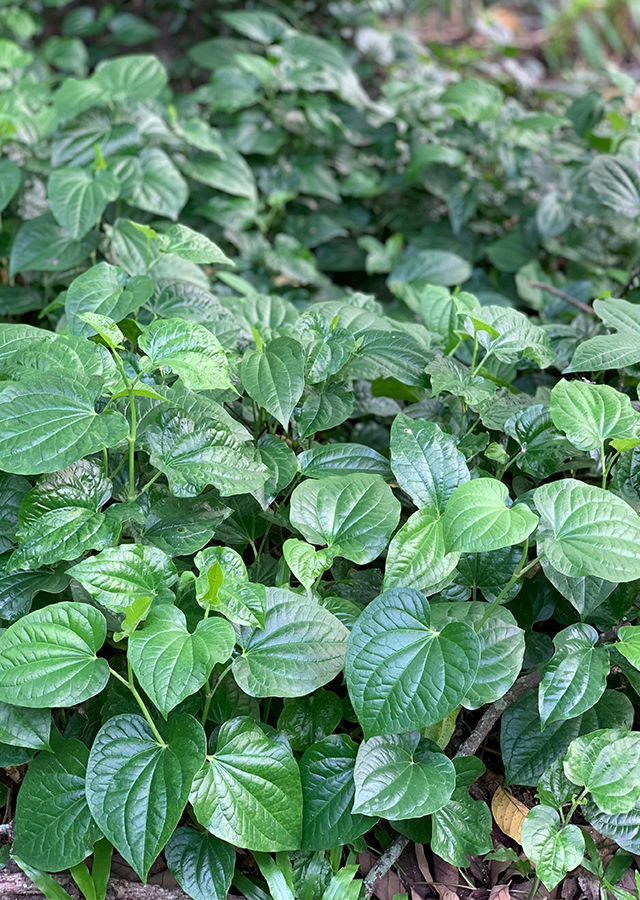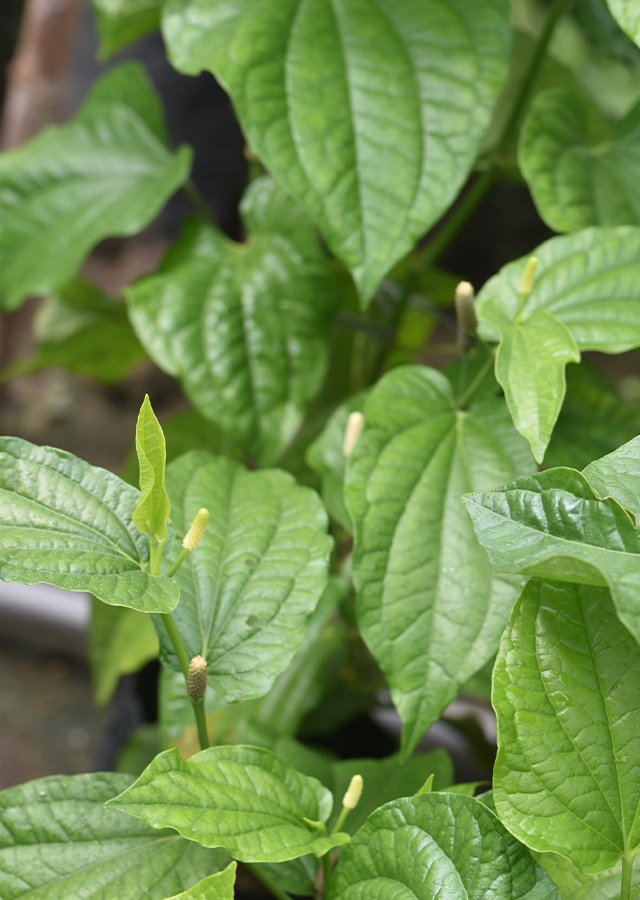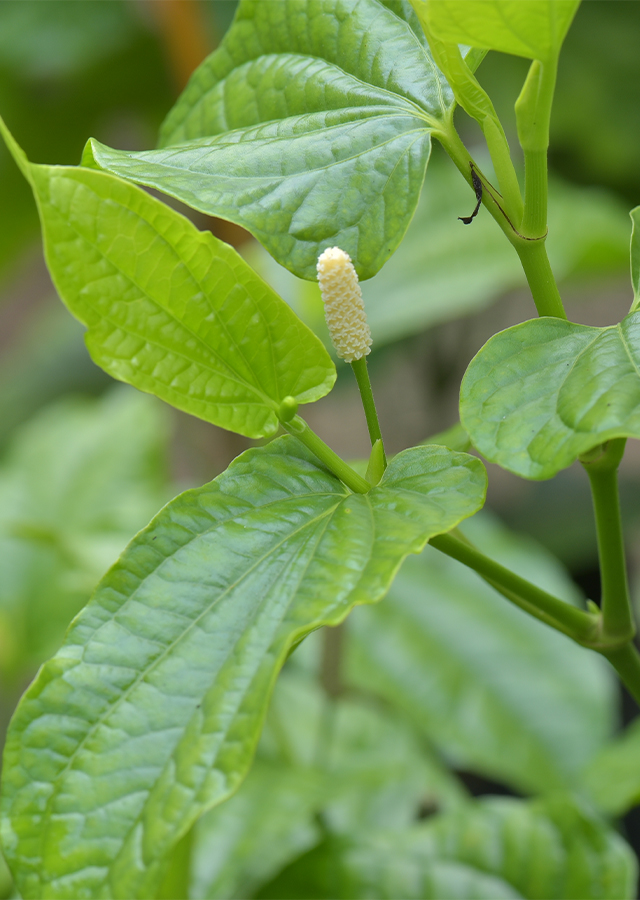Wild Betel
Piper sarmentosum Roxb.
Piperaceae
Location in our garden
Principal



Synonym
Chavica hainana C.DC.
Chavica sarmentosa (Roxb.) Miq.
Peperomia sarmentosa (Roxb.) A.Dietr.
Habitus
Herbaceous. A low-growing evergreen perennial herb or subshrub, can grow 30-40 cm high
Part Used
Leaves
Fruit
Roots
Growing Requirements
Need Shade
Habitat
Forest
Overview
Wild betel is native to Vietnam and elsewhere in South-East Asia. It is found from the tropical areas of South-East Asia, North-East India, and South China, and as far as the Andaman Islands. This spreading vine is fast growing and has many uses. Eaten raw in salads or cooked with other greens or dishes, or wrap meats and cook in oven or on stove or grill, and used medicinally in Asia.
Vernacular Names
Môrech ansai (Cambodian), Kadok batu (Malaysia), Patai-butu (Tagalog-Philippines), Cha phlu (Thailand), Tiêu lốt (Vietnamese), Karuk (Indonesia).
Agroecology
Wild betel grows in thickets up to 600 m altitude, preferably in shady circumstances. The plant can be invasive, so needs to be given space to roam. It does well as an understorey plant in a woodland. They tend to creep along the ground. It is invasive in Hawaii and Pohnpei, where it can smother the ground and compete with agricultural and natural vegetation.
Morphology
- Rhizome - creeping underground rhizomes.
- Stems - erect or ascending, slightly hairy, brownish, often stoloniferous herb or shrublet.
- Leaves - alternate, simple, glossy dark green, heart-shaped. The leaves emit a pungent peppery scent when crushed, with 2-8 cm long petiole, lower leaves ovate-cordate, 7-15 cm x 5-10 cm, 5-7-veined, highest leaves obliquely oblong, 7-11 cm x 3-5 cm, 3-veined.
- Flowers - inflorescence an erect spike, 1-2 cm long, bracts circular, creamy white, about 1 cm in diameter, stamens short, stigmas 3-4.
- Fruits - a berry, connate to each other and adnate to bract but with free apex.
Cultivation
Propagated by seeds, also by stem cuttings where it spreads from the fragments and rhizomes that have a root and sprout at each node.
Chemical Constituents
Saponins, polyphenol, flavonoids, essential oils, pellitorine, guineensine, brachystamide B, sarmentine, sarmentosine, 2 lignans, β- sitosterol, stigmasterol, 2-furanmethanol, 2-pentoic acid, benzene, benzaldehyde.
Traditional Medicinal Uses
- The whole plant is anodyne, antiinflammatory, expectorant, to cure skin diseases, rheumatism, headache, diarrhoea, and toothache. Plant also taken for diuretic and antioxidant properties, to reduce blood sugar and improve diabetes.
- The root is chewed with betel nut, it is helpful for the treatment of coughs and asthma; with nutmeg and ginger it is used to treat pleurisy; crushed with salt is used to relieve toothache by the Chinese and Thais.
- The leaves as carminative in India and South China as well as in Indonesia. It is used for feverish diseases, digestive disorders, and toothache. The extract may be applied externally to treat pain in the bones. Leaves boiled in water and taken to treat coughs, flu, and malarial fever. Leaves also chewed with betel nut and swallowed as remedy for coughs and asthma. Leaves pounded and used as poultice for headaches. Leaf decoction applied as body rub for body aches.
Part Used
Reference Sources
- CABI. (2019). Invasive Species Compendium - Piper sarmentosum. https://www.cabi.org/isc/datasheet/119782. 26-08-2020.
- Rukachaisirikul, T., Siriwattanakit, P., Sukcharoenphol K., Wongvein, C., Ruttanaweang, P., Wongwattanavuch, P., and Suksamrarn, A. (2004). Chemical Constituents and Bioactivity of Piper sarmentosum. Journal of Ethnopharmacology Vol 93, pp. 173-176. https://doi.org/10.1016/j.jep.2004.01.022. 26-08-2020.
- Jansen, P.C.M. (1999). Piper sarmentosum Roxb. ex Hunter. In: de Guzman, C.C. and Siemonsma, J.S. (Editors). Plant Resources of South-East Asia No. 13: Spices. Backhuys Publisher, Leiden, The Netherlands, p. 261. 26-08-2020.
- Fern, K. (2019). Useful Tropical Plants. Piper sarmentosum. http://topical.theferns.info/viewtropical.php?id=Piper+sarmentosum. 26-08-2020.
- Top Tropicals. (No date). Piper sarmentosum. https://toptropicals.com/catalog/uid/Piper_sarmentosum.htm. 26-08-2020.
- Waman, A.A., Bohra, P., Chahraborty, G. (2019). Vegetative Propagation of Piper sarmentosum Roxb.- A Medicinally Important Species. https://www.researchgate.net/publication/332886245_Vegetative_Propagation_of_Piper_sarmentosum_Roxb-_A_Medicinally_Important_Species. 13-09-2020.


